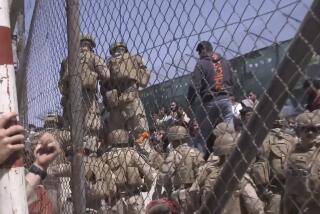Taliban Minister Gives Up
- Share via
WASHINGTON — The Taliban foreign minister turned himself in to officials in the southern Afghan city of Kandahar on Friday, becoming the highest-ranking such official to do so, a U.S. defense official said.
Wakil Ahmed Mutawakel was transferred to the U.S. military base at the city’s airport, where he was being held Friday night, Lt. Col. Martin Compton said.
Omar Samad, a spokesman for the Afghan Foreign Ministry, said the interim government had “been expecting some important Taliban leaders who are on the run to either turn themselves in or to be caught and to be brought to justice,” according to Associated Press.
Meanwhile, more than 50 U.S. soldiers began clearing a site in southeastern Afghanistan where a U.S. airstrike killed several suspected Al Qaeda holdouts--although no evidence has suggested that Osama bin Laden was among them, Pentagon officials said.
The U.S. troops’ mission took them to Zhawar Kili, which has been the focus of intense and repeated bombing. The most recent air attack occurred Monday, when a missile fired by an unmanned Predator plane struck a group of men traveling in a convoy within hours of several intelligence reports that Al Qaeda fighters were in the convoy, Gen. Richard B. Myers, chairman of the Joint Chiefs of Staff, said at a Pentagon briefing.
Despite reports that a tall Arab--perhaps Bin Laden--was among the dead, Myers said, defense strategists “simply have no idea” if he was there. Intelligence officials said they had no reason to believe that the Al Qaeda leader was slain. However, Defense Secretary Donald H. Rumsfeld cautioned, “We haven’t ruled anything in or out.”
The soldiers waited until daylight to begin their sweep for any documents, equipment or other items that might help intelligence officials, Myers said. It remained unclear how many individuals were killed and who they were, he said.
“That’s what they’re in there gathering the intelligence on,” Myers said.
The Predator, a windowless 27-foot drone, was originally built as a surveillance craft for the Air Force. But early in the war, the CIA debuted its version of the plane, armed with Hellfire missiles, in strikes over Afghanistan. Myers declined to say whether the Predator that launched Monday’s strike belonged to the Pentagon or the CIA.
Pentagon officials have portrayed their actions as aggressive but carefully orchestrated to avoid unplanned casualties, following the release this week of 27 detainees who were held after Army Rangers seized them in a raid in which an estimated 15 people were killed. Defense Department officials have insisted that the raid was not a mistake, because U.S. and Afghan soldiers were fired on as they entered.
The focus on mistakes in the war intensified this week as Gen. John Jumper, the Air Force chief of staff, issued an order calling for a “down day” on which the Air Force will take a close look at safety procedures and review guidelines on “risk management.” The order, issued Wednesday but made public Friday, affects units in the war in Afghanistan and throughout the world.
Each active-duty unit was ordered to declare a down day before next Friday. The Air Force reserve command will have until March 8. The campaign, the first in several years, will not ground warplanes over Afghanistan, but officials there will be required to review safety procedures during off hours.
In addition to a string of incidents in Afghanistan, there have been crashes and other aircraft problems elsewhere. They include the Feb. 2 crash of a C-21 transport plane that killed both crew members outside Ellsworth Air Force Base, S.D. Although the order did not mention recent accidents, it urged Air Force managers to increase their attention to safety.
“We’re at a point where it’s appropriate to step back, assess our processes from a safety perspective and then carry on with the work our nation is counting on us to complete,” Jumper said in a message posted on the Air Force Web site.
The Air Force has had 13 major aircraft accidents during the last four months, compared with six in the comparable period a year ago, Col. Greg Alston, deputy chief of Air Force safety, told Associated Press. He said 10 of the 13 accidents were attributable to human error.
“It’s not a crisis. It’s a spike” in the statistical pattern, Alston said.
More to Read
Sign up for Essential California
The most important California stories and recommendations in your inbox every morning.
You may occasionally receive promotional content from the Los Angeles Times.













